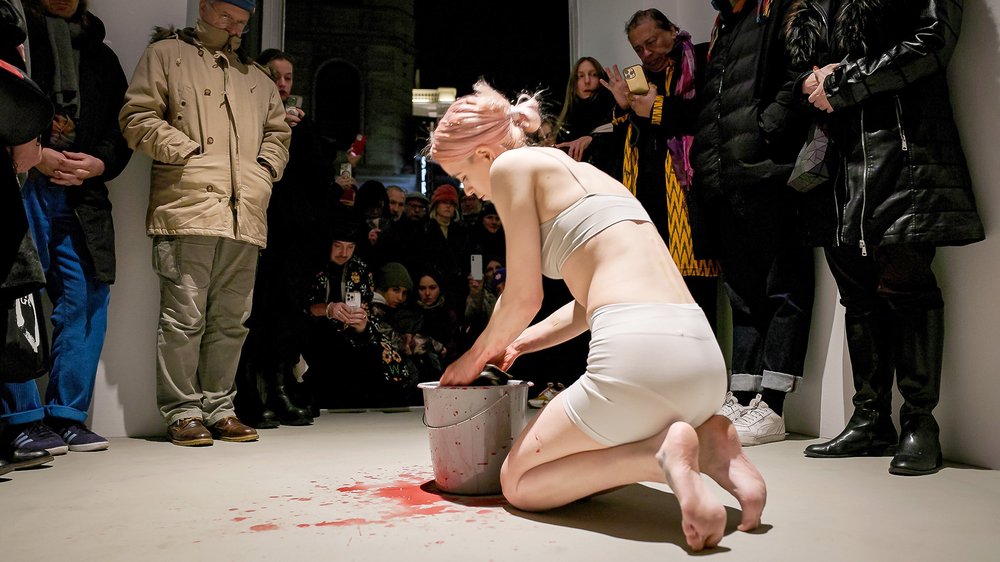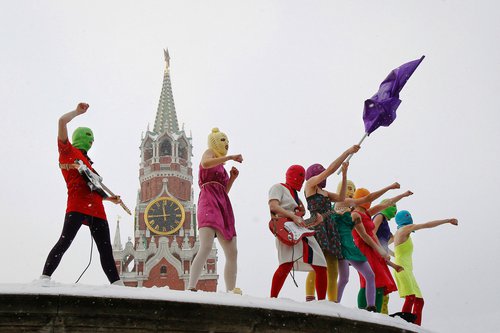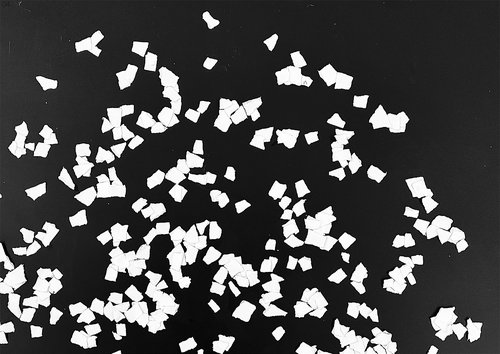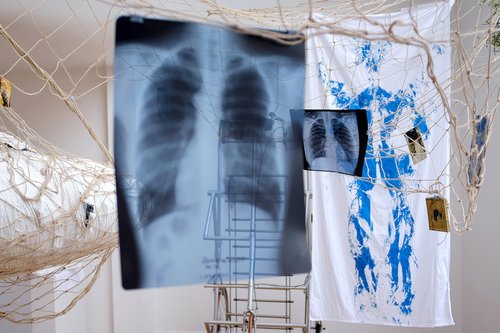Russian Emigre Actionism: Blood, Sweat and Tears

Diana Burkot. 'Sweat and Blood' performance. Vienna Actionism Museum. Photo by Manuel Carreon Lopez. Courtesy of Vienna Actionism Museum
Russian artists in exile are reacting to the tragic realities of today’s world with radical politically charged performances which rarely make the headlines. A solo show of Diana Burkot, a member of Pussy Riot, at Vienna’s Actionism Museum offers a glimpse into the scene, which is often overlooked, yet is a small fragment of a much bigger picture.
It is fair to say that we live in an era of actionism and performativity. While it may not be a golden age (and who is to say what constitutes that) actionism and performativity are once again centre stage in the art world, reflecting the turbulent times we live in, the ongoing brutal wars, the countless socio-economic problems and a pervasive atmosphere of uncertainty.
Perhaps the most interesting and, at times, radical actions and performances are by Russian emigre artists who are living scattered around Europe. The opening of the solo exhibition of Diana Burkot (b. 1985) in Vienna gives us pause to reflect not only on the themes that have inspired her performances and her work over the years but also on the state of emigre actionism in general.
Curated by Julia Moebus-Puck ‘Sweat and Blood’ made a splash (more on that later) when it opened at the Vienna Actionism Museum (WAM) in early December last year. A symbiosis of various forms of artistic expression, the exhibition and two performances during the opening explore themes of inner immigration and a journey of self-reflection in an attempt to understand the horrors of war. It is a multidisciplinary exploration of the trauma of war and totalitarianism through the lens of performativity, presented from an intersectional feminist perspective. Burkot is a musician and an artist who became a member of Pussy Riot in 2012 and took part in their legendary Punk Prayer. She managed to evade arrest and prosecution, and her identity as a participant in Punk Prayer was only disclosed by Nadya Tolokonnikova (b. 1989) (declared a foreign agent by the Russian authorities) in 2020 after the statute of limitations had expired.
The opening of ‘Sweat and Blood’ culminated in a performance by Burkot in which she washed the uniform of a Russian soldier in a bucket of her blood, an activity that reflects the deeply patriarchal nature of war and military aggression. The totalitarian and patriarchal regime expects women to remain subservient, regardless of circumstances. Nothing can perhaps serve as a better allegory than literally washing blood off a uniform. ¨War is the initiative of men¨, as Burkot puts it. She has experimented with similar ideas before - while studying at the Rodchenko Moscow School of Photography she staged several performances at various war memorials, using beetroot juice. Washing the memorials with ‘blood’, it was as if she wanted to wash away the militaristic rhetoric being employed by the Russian state in its approach to the remembrance of the Second World War. These performances were called ‘Why does the Hungry Old Man Need a Parade’ and they reflected on how a triumphant and celebratory rhetoric has become the centrepiece of such commemorations, instead of remembering the victims of war. In Vienna Burkot used her own blood for the first time. In what she described as a challenge, 500ml of her blood was drawn just before the performance, with drowsiness and panic attacks kicking in, she persisted. As a fan of the Viennese Actionism movement of the 1960s and 1970s, she found it fitting in this location. “Where else, if not here?” she laughs.
At the centre of the exhibition is an installation which Burkot calls “a fantasy memorial to political trauma”. The installation is presented as a social experiment, which works rather well in the context of the exhibition, the blood-coloured cloth hanging above sends a very clear message. Yet, were it in a luxury hotel or a pretentious gallery, it would be seen in a completely different light. For Burkot, it is all about the specific context and the societal pressure to perceive art in the way one is expected to perceive it – not very different from how a totalitarian society expects its citizens to perceive the surrounding world. “If you conduct a social experiment, and eight out of ten say that the colour black is white, the other two just repeat after them. Everyone has the responsibility to choose, but of course, society and its norms always affect the way we choose, and the way the society chooses is ultimately affected by propaganda” – says Burkot.
Today, Viennese Actionism comes to mind repeatedly. It was a radical attempt at self-reflection by the post-Second World War generation, just as Dadaism before it tried to process the horrors of the Great War. Contemporary actionism, however, has the questionable luxury of attempting to process events even as they take place. It is a response, more than a reflection. As people become desensitised to the horrors of war due to their ability to see it ‘live’ in their social media feeds, anti-war performances and artistic reflection have become commonplace. Many activist groups have incorporated them into their protests. While it may seem that political activists have somewhat appropriated various forms of actionism, the contrast remains stark. For activists, performance is a tool wrapped in a slogan, despite possible artistic merits, their attempts tend to remain obvious and leave nothing to the imagination. “Artistic performance is not like hitting a bullseye. It’s indirect. It uses the language of the art rather than slogans. Actionism is about reflection and abstract thought,” as Burkot puts it.
Simultaneously, actionism continues to be embraced by mainstream art institutions, even in such artistically (and politically) conservative countries as Austria. RAGE by Nadya Tolokonnikova which opened last summer at the OK Centre for Contemporary Arts in Linz, immediately comes to mind. The exhibition, which also kicked off with a spectacular performance, was both a retrospective of Pussy Riot’s conceptual performances and artistic protests, as well as a reflection on the trauma inflicted by political oppression, patriarchal norms and religious dogma. It comes as no surprise that Russian artists, in general, and women artists, in particular, continue to return to the themes of political and religious oppression, for those are the defining characteristics of the current Russian regime. Just a few years ago, it would have been hard to imagine Burkot’s or Tolokonnikova’s exhibitions and performances taking place within the walls of infamously conservative Austrian art galleries.
However, as times change, even conventional institutions begin to embrace actionism and radical thought. Perhaps by popular demand (the RAGE exhibition in Linz has been extended until early January) or simply because they need some time to catch up as usual. Some may say that as contemporary performativity is being embraced by the mainstream, it may become softer and less radical. “As long as museums and galleries don’t dictate the rules, there is freedom. Radical language becomes softer when inside the walls of the art gallery. Many try to hide; everyone tries to live their lives and pretend that they are unaffected by what is happening in the world. For them, the softer, more comfortable language is more suitable. If the aim is to reflect and to have a discussion on the ongoing events, everyone is important.” – Burkot thinks.
Sometimes, actionism becomes drawn into politics against its will. The Party of The Dead, founded by Maxim Evstropov (b. 1979) in 2017, has always been a form of artistic satire on the ongoing political events in Russia, however, since the full-scale invasion of Ukraine, its performances have become almost entirely political. Describing itself as “the biggest and most horizontal party ever”, as the collective considers all the dead to be its members, for better or worse, in recent years, they have had a field day. As death becomes mundane in the eyes and minds of both Western Europeans and Russian immigrants, the subject of death and its performativity has provided the Party of The Dead with endless opportunities. Their performances adopt various forms and take place in different countries, as the members of the art collective have become scattered around the world. Ranging from what they call “necro installations”, that frequently take place at cemeteries and are a response to the seemingly never-ending stream of casualties produced by the war machine to various performances offering a critique of Western European and Georgian politics (just like many of their compatriots, quite a few members of the Party emigrated to Georgia after the full-scale invasion), as well as those satirising the traditional values used by the Russian state to justify its actions. While some may say that the patriarchal and traditionalist rhetoric of Russian propaganda is a low-hanging fruit for artists, that does not mean that activists and performers cannotfind new and imaginative ways to satirise it and show the inherent hypocrisy that lies at its heart. In the summer of 2024, the Party of the Dead held a series of performances as part of their Sabbath Cabaret ‘Farewell to the Motherland’ in Tbilisi.
Inspired by the Witches’ Sabbath and Black Masses, invoking religious, totalitarian and imperialist imagery, it was a striking and painfully brutal attempt to process the feeling of statelessness experienced by many immigrants while simultaneously trying to reflect on the sense of collective guilt and responsibility that strongly lives in many Russians who oppose the war and the regime and have fled the country since 24th February 2022. Trying to process the trauma of ongoing events through the lens of death and Thanatos is nothing new, as the world continues to spin out of control, death becomes mundane and eventually becomes a friend. Rather than trying to ignore it, actionism was always trying to embrace it and to use it as a tool that would allow the living to re-examine the current events.
As many artists find themselves abroad and are faced with the harsh realities of immigration, their performances begin to reflect not only the events happening on the battlefields or in the homeland they left behind but also the surrounding reality of their new respective countries. Perhaps one of the best examples this year was a series of exhibitions called ‘Re: location’ that took place in Paris this year in the studio of Olga Kisseleva (b. 1965). One of them featured a performance by ElikKuka (a duo of Evgeny Kukoverov (b. 1984) and Oleg Eliseev (b. 1985) called ‘Visa Talent’, a reference to the French government’s residence programme. The radical and hilarious performance satirised the governmental bureaucracy and highlighted its absurdity. Eliseev, screaming “Je suis un chien medalist” (I am an award-winning dog) with a shoe on his head and the Paris skyline behind him, somehow perfectly encapsulates the absurdity of the world we are living in and the life that many contemporary artists are currently facing.
Diana Burkot’s performance in Vienna ended with a splash. Once she finished washing the uniform, she picked up the bucket and threw her blood into the audience gathered outside the museum. Some were quick to step aside, and most of the blood landed on a car that was parked nearby. After it was all over, as the warm blood ran along the floor of the museum and the audience began to disperse, some were wondering what the owner of the car might think. She soon arrived, got in and drove away without noticing that her grey and dull VW was now covered in blood. There she was, driving through the streets of Vienna, as a moving reminder that actionism is indeed very much alive. An accidental artwork and an homage to the heyday of Viennese Actionism. Let’s hope that if the owner encountered the police on her way home, they were able to recognise the symbolism and the artistic merit.
Pussy Riot – Diana Burkot. Sweat and Blood
Vienna, Austria
6 December 2024 – 31 January 2025

















